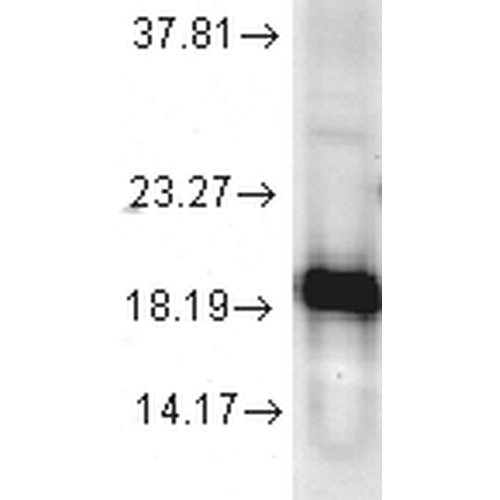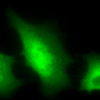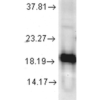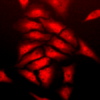Anti-Superoxide dismutase (SOD) Cu/Zn Antibody (13001)
$479.00
| Host | Quantity | Applications | Species Reactivity | Data Sheet | |
|---|---|---|---|---|---|
| Rabbit | 100ul | WB,IHC,ICC/IF,IP,ELISA | Human, Mouse, Rat, Bovine |  |
SKU: 13001
Categories: Antibody Products, Enzymes and Enzyme Inhibitor Antibodies, Products
Overview
Product Name Anti-Superoxide dismutase (SOD) Cu/Zn Antibody (13001)
Description Anti-Superoxide dismutase (SOD) Cu/Zn Rabbit Polyclonal Antibody
Target Superoxide dismutase (SOD) Cu/Zn
Species Reactivity Human, Mouse, Rat, Bovine
Applications WB,IHC,ICC/IF,IP,ELISA
Host Rabbit
Clonality Polyclonal
Immunogen Rat Cu/Zn SOD
Properties
Form Liquid
Concentration 1.0 mg/mL
Formulation PBS pH 7.0, 50% glycerol, and 0.09% sodium azide.
Buffer Formulation Phosphate Buffered Saline
Buffer pH pH 7.0
Buffer Anti-Microbial 0.09% Sodium Azide
Buffer Cryopreservative 50% Glycerol
Format Purified
Purification Purified by antigen immunoaffinity chromatography
Specificity Information
Specificity This antibody detects a 23kDa protein in human (and a 19kDa protein in other species) on SDS-PAGE immunoblots, corresponding to the molecular mass of Cu/Zn SOD. This antibody recognizes human, mouse, rat, canine, porcine, rabbit, ovine, Xenopus, and bovine Cu/Zn SOD.
Target Name Superoxide dismutase [Cu-Zn]
Target ID Superoxide dismutase (SOD) Cu/Zn
Uniprot ID P07632
Alternative Names EC 1.15.1.1
Gene Name Sod1
Accession Number NP_058746.1
Sequence Location Cytoplasm. Nucleus
Biological Function Destroys radicals which are normally produced within the cells and which are toxic to biological systems.
Research Areas Enzymes
Background Superoxide dismutase (SOD) is an endogenously produced intracellular enzyme that catalyzes the dismutation of the superoxide radical O2- to oxygen and hydrogen peroxide which are then metabolized to H2O and O2 by catalase and glutathione peroxidase. SODs play an important role in antioxidant defense mechanisms. Three different SOD isoenzymes are found in mammalian cells: SOD1, SOD2, and SOD3.
Application Images




Description Immunocytochemistry/Immunofluorescence analysis using Rabbit Anti-SOD (Cu/Zn) Polyclonal Antibody (13001). Tissue: Cervical cancer cell line (HeLa). Species: Human. Fixation: 2% Formaldehyde for 20 min at RT. Primary Antibody: Rabbit Anti-SOD (Cu/Zn) Polyclonal Antibody (13001) at 1:120 for 12 hours at 4°C. Secondary Antibody: FITC Goat Anti-Rabbit (green) at 1:200 for 2 hours at RT. Counterstain: DAPI (blue) nuclear stain at 1:40000 for 2 hours at RT. Localization: Cytoplasm. Nucleus. Magnification: 100x. (A) DAPI (blue) nuclear stain. (B) Anti-SOD (Cu/Zn) Antibody. (C) Composite.

Description Western blot analysis of Human Cell line lysates showing detection of SOD1 protein using Rabbit Anti-SOD1 Polyclonal Antibody (13001). Load: 15 µgprotein. Block: 1.5% BSA. Primary Antibody: Rabbit Anti-SOD1 Polyclonal Antibody (13001) at 1:1000 for 2 hours at RT. Secondary Antibody: Donkey Anti-Rabbit IgG: HRP for 1 hour at RT.

Description Immunocytochemistry/Immunofluorescence analysis using Rabbit Anti-SOD (Cu/Zn) Polyclonal Antibody (13001). Tissue: Cervical cancer cell line (HeLa). Species: Human. Fixation: 2% Formaldehyde for 20 min at RT. Primary Antibody: Rabbit Anti-SOD (Cu/Zn) Polyclonal Antibody (13001) at 1:120 for 12 hours at 4°C. Secondary Antibody: APC Goat Anti-Rabbit (red) at 1:200 for 2 hours at RT. Counterstain: DAPI (blue) nuclear stain at 1:40000 for 2 hours at RT. Localization: Cytoplasm. Nucleus. Magnification: 20x. (A) DAPI (blue) nuclear stain. (B) Anti-SOD (Cu/Zn) Antibody. (C) Composite.
Handling
Storage This antibody is stable for at least one (1) year at -20°C. Avoid multiple freeze-thaw cycles.
Dilution Instructions Dilute in PBS or medium that is identical to that used in the assay system.
Application Instructions Immunoblotting: use at 0.5-1.0ug/mL
Positive control: Rat brain tissue extract
Immunohistochemistry: use at 1-10ug/mL
These are recommended concentrations.
Endusers should determine optimal concentrations for their applications.
Positive control: Rat brain tissue extract
Immunohistochemistry: use at 1-10ug/mL
These are recommended concentrations.
Endusers should determine optimal concentrations for their applications.
References & Data Sheet
Data Sheet  Download PDF Data Sheet
Download PDF Data Sheet
 Download PDF Data Sheet
Download PDF Data Sheet






